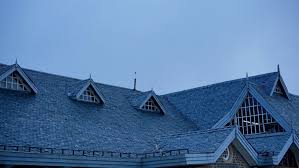Home Improvement
How to Choose the Perfect Roof for Your Home’s Climate and Style: A Comprehensive Decision-Making Guide
Published
2 months agoon
By
Prime Star
Selecting the right roof for your home is more than just an aesthetic choice. Your roof is the first line of defense against the elements and plays a critical role in protecting your family, maintaining energy efficiency, and boosting your home’s curb appeal and resale value. However, the ideal roofing material and style depend heavily on your local climate, architectural design, and personal preferences.
This comprehensive guide will walk you through the key factors to consider when choosing the perfect roof for your home’s unique climate and style. Understanding these factors will empower you to make a confident, informed decision that enhances both the functionality and beauty of your home.
Why Choosing the Right Roof Matters
A roof is not just a protective shell it impacts everything from your home’s energy consumption to its overall structural integrity. Choosing an inappropriate roofing material can lead to premature wear, costly repairs, or even structural damage. Moreover, certain roofing styles complement specific architectural designs, making the right roof essential for preserving or enhancing your home’s aesthetic value.
For homeowners, the challenge lies in balancing durability, cost, style, and climate suitability. An optimal roof maximizes protection while harmonizing with your home’s design and the environmental conditions it faces.
Understanding Your Local Climate: The Foundation of Your Roofing Decision
Climate is arguably the most critical factor in selecting roofing materials. Different regions have unique weather challenges, and your roof must be able to withstand them effectively.
- Hot and Sunny Climates: In regions with intense sun and high temperatures, roofing materials that reflect heat and resist UV degradation are essential. Options like metal roofs or reflective asphalt shingles help reduce cooling costs and maintain comfort.
- Cold and Snowy Climates: Roofs in cold climates must withstand heavy snow loads and resist ice dams. Materials like metal roofing or slate are excellent choices because they shed snow efficiently and provide superior durability.
- Wet and Humid Climates: High humidity and frequent rainfall require roofing materials that resist mold, mildew, and water damage. Clay tiles, metal, or treated wood shingles often perform well in such environments.
- Windy and Storm-Prone Areas: Homes in hurricane or tornado-prone regions need roofing systems tested for high wind resistance. Impact-resistant shingles or metal roofing systems offer superior protection against severe weather.
Understanding your local weather patterns will help narrow down roofing options that provide longevity and reduce maintenance needs.
Popular Roofing Materials and Their Climate Suitability
Each roofing material has distinct characteristics that make it better suited for particular climates and home styles. Below are common roofing types and insights on their best applications:
Asphalt Shingles
The most widely used roofing material in North America, asphalt shingles offer affordability, ease of installation, and versatility. They perform well in moderate climates but may degrade faster in extreme heat or severe storms.
Metal Roofing
Metal roofs are durable, lightweight, and excellent for reflecting heat. They’re highly resistant to wind, fire, and snow, making them ideal for a broad range of climates. Their sleek, modern appearance complements contemporary and industrial architectural styles.
Clay and Concrete Tiles
Popular in Mediterranean and Southwestern homes, clay and concrete tiles are highly durable and excel in hot, dry climates. They provide excellent thermal insulation but require sturdy roof framing due to their weight.
Slate Roofing
Slate offers unmatched elegance and longevity, often lasting over a century. It’s suitable for cold, wet climates due to its water resistance and durability but comes with a higher price tag and weight considerations.
Wood Shingles and Shakes
Wood provides natural beauty, particularly for rustic or traditional home designs. However, it’s best used in dry climates since wood is susceptible to rot, mold, and insect damage in humid environments.
Architectural Style and Roof Design: Harmonizing Function and Aesthetics
Your home’s architectural style plays a significant role in selecting a roofing material and design. A roof that complements your home’s design enhances curb appeal and property value.
- Traditional and Colonial Homes: Asphalt shingles, slate, or wood shakes often suit these classic designs, providing timeless appeal.
- Modern and Contemporary Homes: Metal roofs or flat roofing systems align with sleek lines and minimalist aesthetics.
- Mediterranean or Spanish-Style Homes: Clay or concrete tiles enhance the signature look of these styles.
- Rustic and Cabin Homes: Wood shingles or shakes lend warmth and a natural feel.
Additionally, roof pitch and shape impact both style and function. Steeper roofs shed snow and rain more effectively, while flatter roofs may require specific waterproofing measures.
Budget Considerations: Balancing Cost with Longevity and Performance
While it’s tempting to choose the lowest upfront cost, investing in a quality roofing system pays off through extended durability and reduced maintenance expenses. Asphalt shingles are budget-friendly but may need replacement every 15–30 years, whereas metal, slate, or tile roofs often last 50 years or more.
Factor in installation complexity and structural reinforcement costs, especially with heavy materials like slate or tile. Also, consider the long-term savings from energy-efficient roofing that lowers heating and cooling bills.
Energy Efficiency and Environmental Impact
Green building trends have made energy efficiency a top priority in roofing decisions. Reflective roofing materials reduce heat absorption, lowering cooling costs during hot months. Additionally, materials like metal roofs can be recycled, and some roofing systems incorporate solar panels or green roofs to further enhance sustainability.
Maintenance Requirements: Planning for the Long Haul
Every roofing material requires some degree of maintenance. Asphalt shingles need periodic inspection for curling or missing shingles, while wood requires treatment against pests and rot. Metal and tile roofs generally demand less maintenance but should still be inspected for debris or damage after storms.
Understanding maintenance demands upfront helps ensure your roof’s longevity and saves money on avoidable repairs.
Frequently Asked Questions (FAQ)
Q: How long should a new roof last?
Roof lifespan varies by material—typically 15-30 years for asphalt shingles, 40-70 years for metal, and up to 100+ years for slate. Proper maintenance extends longevity.
Q: Can I install a new roof over my existing one?
In some cases, yes, but it depends on local building codes and the condition of the existing roof. Consulting a professional is recommended.
Q: How do I know if my roof needs replacing?
Signs include missing or curling shingles, leaks, frequent repairs, and noticeable aging. A professional inspection can confirm.
Q: Does roof color affect energy efficiency?
Yes. Light-colored or reflective roofs can reduce heat absorption, lowering cooling costs in warm climates.
Q: What roofing options are best for extreme weather?
Metal roofs, impact-resistant shingles, and tile roofs tend to perform well in high winds, hail, and heavy snow.
Conclusion
Choosing the perfect roof for your home is a vital decision that affects your home’s safety, energy efficiency, and curb appeal for decades. By considering your local climate, architectural style, budget, and maintenance expectations, you can select a roofing system that meets your needs and enhances your home’s value.
Partnering with experienced professionals like Premier Roofing ensures you receive expert guidance and quality installation tailored to your unique situation. Reach out today to explore roofing options that combine durability, style, and performance for your home’s perfect fit.
About Premier Roofing
At Premier Roofing, we know that choosing the perfect roof involves more than picking materials—it’s about finding a tailored solution that balances durability, aesthetics, and climate suitability. Our team of experienced roofing professionals works closely with homeowners to assess their unique needs and recommend roofing systems designed for long-lasting performance and style.
We pride ourselves on delivering expert craftsmanship, transparent communication, and quality materials. Whether you’re building a new home or replacing an aging roof, Premier Roofing is committed to providing solutions that protect your investment and enhance your home’s beauty.
Business Name: Premier Roofing
Address: 85 Main St Suite 3, Sidney, NY 13838
Phone Number: (607) 563-9099

Data Privacy and Confidentiality in Legal AI: Keeping Sensitive Matters Secure

Jodi Faeth: What Happened to Mike Wolfe’s Ex-Wife After Divorce?

How GEO Helps Startups Compete With Enterprise-Level AI Visibility

Who Is Cassandra Marino? Caitlyn Jenner’s Daughter Who Lives a Private Life

Get to Know Nathan Andersen: A. J. Cook’s Husband and Proud Family Man

From Digital to Tangible: The Human Impact of Cryptocurrency to Fiat Adoption

The Real Story of Melissa Meeks, Jeremy Meeks’ Famous Ex-Wife

MegaCustom: Personal Gifts Made Beautiful

Design Something Special with MegaCustom

Top 10 SEO Agencies for Barber Shops

Who Is Marlene Knaus? The Untold Story of Niki Lauda’s First Wife

Curious About JOI Database? Read This First Before You Click Anything

Jacqueline Bernice Mitchell: The Inspiring Story of Jerry Rice’s Ex-Wife

Should You Use Wooflix in 2025? Honest Review and Best Alternatives

Where Is Noelle Watters Now? Jesse Watters’ Ex-Wife’s Life After Divorce

Where Is Barbara Boothe Now? Inside Her Life After Larry Ellison

Alisande Ullman Today: What Happened After Her Divorce from Leslie Nielsen?

Where Is Tanya Hijazi Now?: All About Rick James’ Former Wife

Wendy Lang: Meet the Therapist Married to Cenk Uygur

Mickey Middleton: The Untold Story of Bryan Cranston’s First Wife

Data Privacy and Confidentiality in Legal AI: Keeping Sensitive Matters Secure

Jodi Faeth: What Happened to Mike Wolfe’s Ex-Wife After Divorce?

How GEO Helps Startups Compete With Enterprise-Level AI Visibility

Who Is Cassandra Marino? Caitlyn Jenner’s Daughter Who Lives a Private Life

Get to Know Nathan Andersen: A. J. Cook’s Husband and Proud Family Man

From Digital to Tangible: The Human Impact of Cryptocurrency to Fiat Adoption

The Real Story of Melissa Meeks, Jeremy Meeks’ Famous Ex-Wife

MegaCustom: Personal Gifts Made Beautiful

Design Something Special with MegaCustom

Top 10 SEO Agencies for Barber Shops
Categories
Trending
-

 Celebrity6 months ago
Celebrity6 months agoWho Is Marlene Knaus? The Untold Story of Niki Lauda’s First Wife
-

 Entertainment5 months ago
Entertainment5 months agoCurious About JOI Database? Read This First Before You Click Anything
-

 Celebrity3 months ago
Celebrity3 months agoJacqueline Bernice Mitchell: The Inspiring Story of Jerry Rice’s Ex-Wife
-

 Entertainment5 months ago
Entertainment5 months agoShould You Use Wooflix in 2025? Honest Review and Best Alternatives
